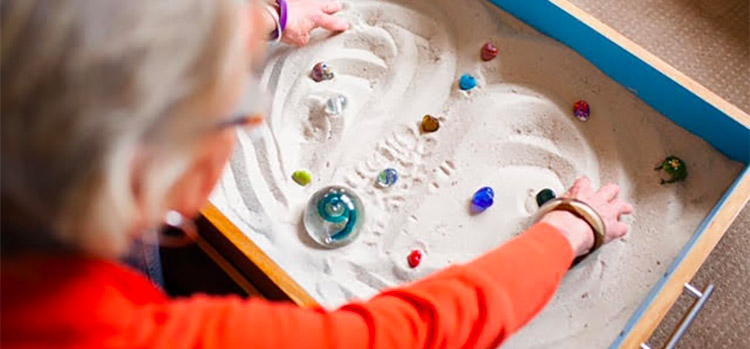
MyCareSpace had a chat with Patricia Reilly from Beyond The Masks about Sandplay Therapy. This therapy is not yet well known and we thought we'd dig a little deeper and see what we could find out.
MCS: What is Sand Play Therapy?
Patricia:
The history of Sandplay Therapy is over 100 years old. Dora Maria Kalff, Jungian Psychologist and student of Margaret Lowenfeld, developed a therapeutic method she called SandplayTherapy in the late 50's.
Sandplay Therapy is a way of expressing feelings and personal experiences. It is a nonverbal, therapeutic intervention that makes use of a sandtray, symbols and sometimes water, to create miniature worlds that reflect a person’s inner thoughts, struggles and concerns.
Symbols are arranged in the sand and in doing so provide visual representation of emotions, relationships, issues or material from the unconscious. Significant emphasis is placed upon safety, self-discovery and awareness of physical and emotional processes.
MCS: How does Sandplay Therapy Work?
Patricia:
Sandplay Therapy is a highly individual, profoundly powerful, safe and effective method for working with clients of all ages, including traumatised clients. It allows deeper aspects of the psyche to be worked with naturally and in safety. It taps into the unconscious mind, releasing any thoughts, feelings or emotions that have been hidden or buried. Sandplay enriches a verbal counselling process by inviting us to attend to the non-verbal communications that emerge spontaneously from our hands and body as a picture that “feels right” is created.
MCS: Who Can Become a Sandplay Therapist?
Patricia:
There are several organisations where training to become a Sandplay Therapist is provided. Amongst them are;
- STANZA (Sandplay Therapy Association of NZ and Australia) which offers in-depth and systemic learning in Sandplay Therapy
- Into Blue Expressive Therapies Institute
- ISST (International Society for Sandplay Therapy)
This training is suitable for: Psycho-Therapists and Counsellors; Psychologists; Psychiatrists; Social Workers; Play Therapists; advanced trainers and others in mental health professions.
MCS: Who Could Benefit from Sandplay Therapy?
Patricia:
Sandplay therapy can be used as successfully with adults as with children and can assist in the treatment of:
- Trauma (relational, physical or sexual abuse, natural disasters etc.)
- Grief and Loss
- Anger and Behavioural problems
- Unexplained fears and anxieties
- Adjustment disorders
- Managing a chronic or life threatening illness
- Depression
- Self esteem
MCS: Is Sandplay Therapy Evidence Based?
Patricia:
Whilst it is difficult to find data relating to evidence based sandplay therapy, numerous research and case studies provide comprehensive documentation of the efficacy of Sandplay. There are several Australian research papers one of which by Patrick O’Brien. His 1998 dissertation is an analysis of using sandplay and associated modalities with children in schools. O’Brien draws links between sandplay and symbol work processes and Howard Gardener’s theories of multiple intelligences. O’Brien produces some of Australia’s first statistical evidence for the effectiveness of these dynamic experiential methods.
Sandplay therapy is grounded in Jungian Psychology.
From a personal perspective, in my work as a counsellor, I find sandplay therapy to be a gentle, unobtrusive way of working with clients of all ages. It allows the client to relax and be guided by their intuition in their choice and placement of the symbols.
I recall one client in particular with whom I had been working for about six months on a weekly basis. This client suffered extreme anxiety and her outlook on life was extremely bleak. I suggested that she try a session in the sand. My client complied although she was very sceptical and a one stage during her session she looked up at me and said that she was not getting anything at all from the experience. I asked her to sit back, take a deep breath and when ready, to resume her “story” in the sand. My client did as instructed and continued repositioning her chosen symbols; after a few minutes, she gasped and looked up at me and said “I know what it is! I’ve worked it out!
I have seen this woman a few times since this session and she now seems extremely confident and happy!
I have a monthly sandplay session and find it far more beneficial for me than the traditional “talking" form of counselling. I feel that I am able to come to a deeper understanding of whatever problems or anxieties I may be experiencing and am left feeling refreshed and psychologically strong!
MCS: How and where can an NDIS PArticipant include Sandplay Therapy in their Plan?
Patricia:
The NDIS support category used to fund Sandplay Therapy is either Individual Counselling or Improved Daily Living.
For more information about Sandplay Therapy, get in contact with Patricia.
NDIS THERAPY FINDER - FREE SERVICE
LET US FIND YOU A SKILLED SUPPORT WORKER

